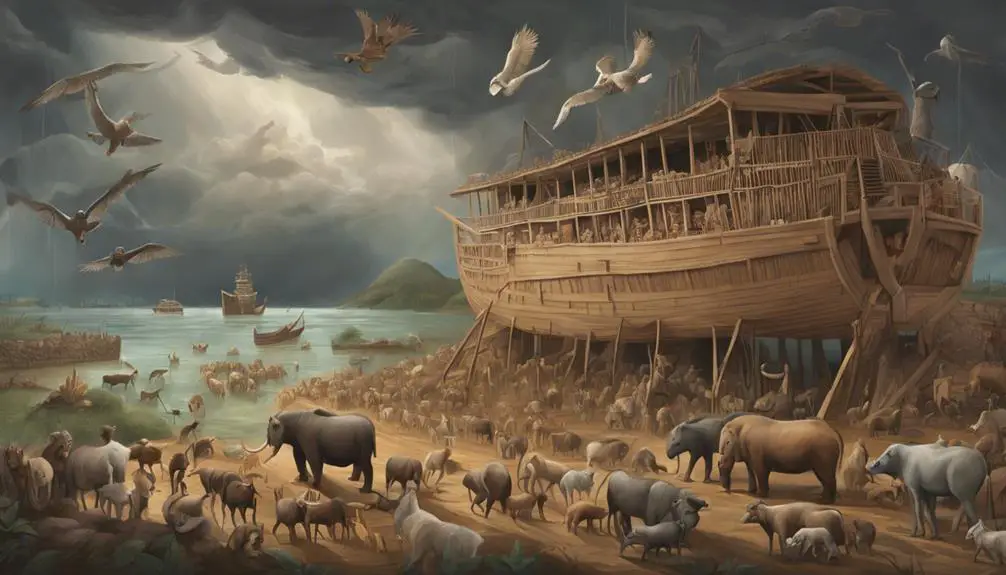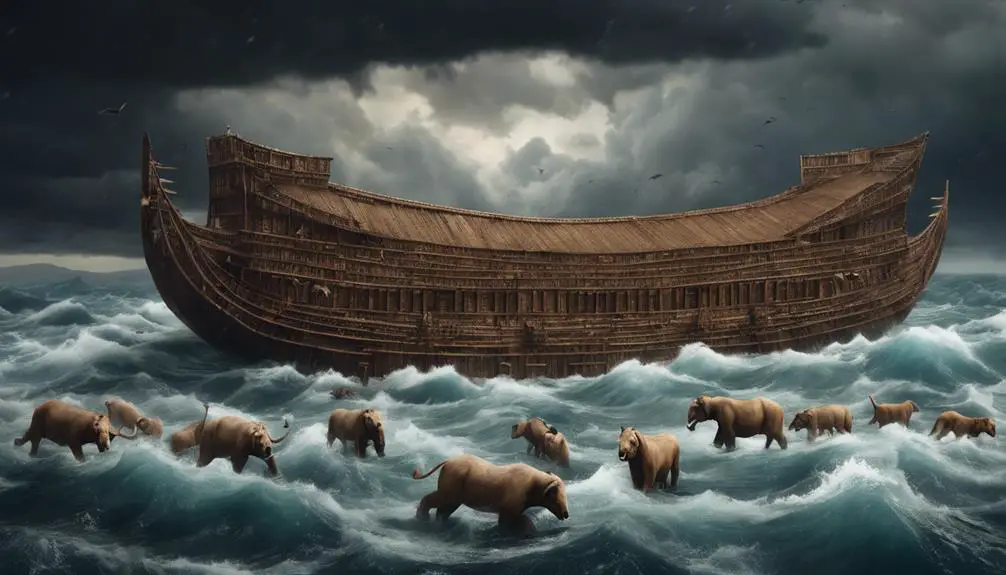Learn how 'hamas' in Genesis 6 reveals insights into divine justice and human morality, urging a deeper reflection on our actions today.

Hamas in the Bible Genesis 6
Imagine you're exploring the ancient text of Genesis 6, where the concept of 'hamas'—often translated as violence or corruption—plays a pivotal role in the narrative. This term not only signifies the moral decay that led to divine intervention in the form of a flood but also encapsulates a broader discourse on human behavior and divine displeasure.
As you sift through the layers of this ancient story, you'll find that understanding 'hamas' in its original Hebrew context opens up a fascinating dialogue about justice, morality, and the consequences of our actions.
Let's uncover what lessons Genesis 6 might hold for the modern world, shall we?
Key Takeaways
- 'Hamas' in Genesis 6 signifies widespread moral decay and injustice leading to divine intervention.
- The narrative underscores the severe consequences of societal moral failure through the flood judgment.
- Noah's righteousness highlights the importance of ethical living amidst prevailing corruption.
- The story of 'Hamas' and the flood offers lessons on accountability and the need for ethical integrity today.
Understanding 'Hamas' in Hebrew

In exploring the term 'Hamas' within the Hebrew context, it's crucial to understand that it signifies violence, corruption, and wrongdoing, deeply impacting the narrative of Genesis 6. The word's origins are embedded in ancient Hebrew, reflecting a complex concept that's challenging to convey in English or any other language. This linguistic hurdle represents a significant translation challenge, as 'Hamas' encompasses a broad spectrum of negative human behaviors and societal corruption.
Understanding 'Hamas' demands a nuanced appreciation of its linguistic roots and the contexts in which it's used. The Hebrew language, rich in its ability to convey deep philosophical and ethical concepts through single words, presents 'Hamas' as not merely an act of violence but an embodiment of moral decay and injustice. This multifaceted meaning is difficult to capture with a single English word or phrase, leading to potential misunderstandings of the text's original intent.
The scholarly exploration of 'Hamas' underscores the importance of appreciating word origins and the complexities inherent in translating ancient texts. It's a reminder that beyond the literal translation lies a deeper need to understand the cultural, historical, and ethical nuances that shape a term's meaning and its significance within a narrative like that of Genesis 6.
The Context of Genesis 6

Genesis 6 unveils a world overwhelmed by the very 'Hamas' that characterizes its downfall, setting a pivotal stage for understanding the narrative's depth and complexities. This chapter is crucial, as it provides a backdrop against which the emergence of Nephilim giants and rampant human wickedness is portrayed. You're introduced to a time when humanity's moral fabric was so degraded that it necessitated divine intervention.
The mention of Nephilim giants in this context isn't just a fantastical element; it serves to highlight the abnormal state of the world. These beings symbolize the breach of natural and divine orders, reflecting the extent of human disobedience and its consequences. The presence of these giants exacerbates the already dire moral situation, illustrating a world in chaos.
Human wickedness, as depicted here, isn't merely about individual sins but a collective moral failure that permeates society. You see a civilization where the inclination of the human heart is only evil continually, underscoring the severity of the situation. This collective moral decay is central to understanding why the narrative progresses towards a drastic divine response. Through this lens, Genesis 6 not only narrates a story of ancient times but also offers timeless insights into human nature and divine justice.
Hamas' and Divine Displeasure

Reflecting on the moral decay highlighted in the previous section, it's crucial to understand how the pervasive 'Hamas' sparked divine displeasure, setting the stage for consequential actions. The term 'Hamas,' representing violence and corruption, underscores the extent of moral ambiguity permeating human actions at the time. This ambiguity wasn't merely a personal failure but highlighted significant societal implications. It's within this context that divine displeasure becomes evident, not as an arbitrary response but as a reaction to the erosion of moral and ethical boundaries.
Aspect |
Description |
Divine Response |
|---|---|---|
Moral Decay |
Widespread 'Hamas' indicative of ethical erosion. |
Displeasure and grief |
Societal Implications |
Breakdown in social order and justice. |
Preparation for action |
Divine Perspective |
Viewing moral ambiguity as antithetical to divine will. |
Consideration of consequences |
This table encapsulates the relationship between human actions characterized by 'Hamas' and the subsequent divine displeasure. It's a reminder that moral ambiguity and societal implications were not taken lightly. Instead, they served as catalysts for divine contemplation on the future of humanity, underscoring the gravity of moral decay beyond individual transgressions.
The Flood as Judgment

Amidst the moral collapse marked by widespread 'Hamas,' the flood emerges as a divine judgment, meticulously executed to cleanse the earth of its pervasive corruption. This act of divine intervention serves not only as a response to the moral degeneration but also highlights a pivotal moment of recalibration in humanity's history. Noah's righteousness stands in stark contrast to the prevailing moral bankruptcy, underscoring the narrative's emphasis on ethical living as a beacon of hope amidst widespread depravity.
The flood, as described in Genesis, transcends a mere historical event, evolving into a symbol of ultimate judgment against unchecked wickedness. It's a global catastrophe that eradicates the corrupted order, paving the way for a new beginning based on moral rectitude. This narrative underscores the severity of the consequences when humanity strays from the path of righteousness.
Through the prism of Noah's righteousness, the flood narrative articulates a profound theological truth: divine judgment, though severe, isn't capricious but is rooted in a quest for moral purity. It serves as a reminder of the potential for renewal that follows adherence to divine will, even in the aftermath of a global catastrophe. This story, therefore, isn't just about destruction but about the possibility of redemption and the importance of living a life aligned with divine expectations.
Lessons for the Modern World

The narrative of the flood, with its profound implications for moral rectitude and divine judgment, offers essential lessons for contemporary society in navigating ethical dilemmas and fostering a just world. You're called to reflect on these ancient lessons to address modern challenges effectively. The story's ethical implications and contemporary parallels become clear as you analyze them in today's context.
Flood Narrative Element |
Ethical Implication |
Contemporary Parallel |
|---|---|---|
Divine Judgment |
Accountability |
Climate Change |
Corruption (Hamas) |
Social Injustice |
Economic Disparities |
Noah's Righteousness |
Integrity |
Ethical Leadership |
Rebirth and Covenant |
Hope and Renewal |
Sustainable Development |
This table elucidates the direct correlation between the ancient text and the pressing issues of our time, urging you to ponder and act upon these parallels. As you navigate the complexities of modern society, the story of the flood serves as a stark reminder of the consequences of moral failure and the rewards of ethical living. It's a call to adopt a stance of integrity, accountability, and hope, ensuring a just and sustainable future for all. Reflecting on these teachings, you're empowered to make informed decisions, leading to a more equitable world.
Frequently Asked Questions
How Has the Interpretation of 'Hamas' in Genesis 6 Evolved Among Different Jewish and Christian Denominations Over the Centuries?
Over centuries, you've seen the interpretation of 'hamas' evolve due to translation variations and manuscript differences among Jewish and Christian denominations. Initially understood broadly as 'violence', deeper dives into language and context have nuanced its meaning.
Scholars from different traditions have debated its implications—ranging from moral corruption to social injustice. This continuous reevaluation showcases the dynamic nature of religious texts and how understanding deepens with scholarly analysis and cross-denominational dialogue.
Can the Concept of 'Hamas' Found in Genesis 6 Be Linked to Any Similar Concepts in Other Ancient Near Eastern Texts or Mythologies?
You're exploring how the concept of 'hamas' aligns with ideas in other ancient texts. Notably, Gilgamesh parallels show a reflection on human wickedness and divine response, akin to the 'hamas' narrative.
Similarly, Enuma Elish features themes of violence that resonate with 'hamas'. These connections suggest a broader Near Eastern discourse on chaos and morality.
Your analysis could reveal how these texts collectively ponder human nature and divine justice.
Are There Any Archaeological Findings That Support or Contradict the Narrative of Widespread 'Hamas' Leading to Divine Judgment as Described in Genesis 6?
You're delving into whether archaeological evidence supports or refutes widespread corruption leading to divine judgement. In this quest, you'll encounter flood geology and the scrutiny of artifact authenticity. These fields critically assess materials and sites that may echo ancient narratives.
However, correlating these findings directly with specific biblical events like 'hamas' in Genesis 6 remains challenging. Scholarly consensus often varies, emphasizing the complexity of linking physical evidence to ancient texts.
How Do Contemporary Theologians Reconcile the Notion of 'Hamas' and Divine Judgment in Genesis 6 With Modern Understandings of Ethics and Morality?
You're navigating a complex terrain where contemporary theologians grapple with reconciling ancient divine judgment with today's ethics and morality.
They delve into the nuances of modern pacifism and ethical relativism, evaluating how these concepts intersect with traditional interpretations of justice and retribution.
This analysis is crucial, as it aims to understand the ethical implications of divine actions in a context vastly different from the ancient world, ensuring a relevant and thoughtful theological discourse.
Has 'Hamas' in Genesis 6 Been Utilized in Any Significant Theological Debates or Controversies Within the Religious Community, and if So, How?
You're likely curious about how the concept of 'hamas' has echoed through theological debates, especially considering its modern implications. Scholars have indeed scrutinized this term, dissecting its definition from Genesis 6 to understand its relevance today.
This analysis often sparks controversy, particularly when debating the ethics of divine judgment. By delving into its historical context, they've illuminated its role in contemporary discussions, revealing how ancient texts influence current moral frameworks.
Conclusion
In your exploration of 'Hamas' in Genesis 6, you've seen how this term, signifying violence and corruption, deeply troubled the divine. The narrative not only illustrates the severity of moral decay that led to the Flood but also serves as a perennial reminder of the consequences of widespread wickedness.
This ancient text, therefore, offers a profound lesson for the modern world: societies engulfed in corruption and violence risk divine judgment, urging a reflection on our collective moral compass.



Sign up